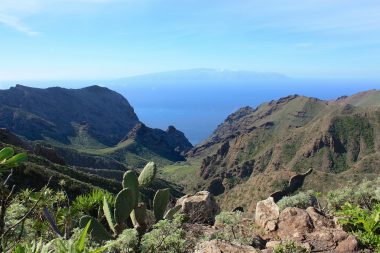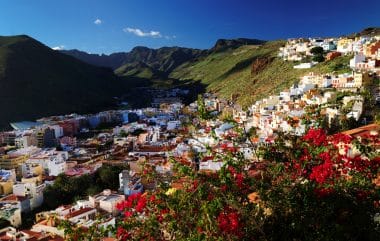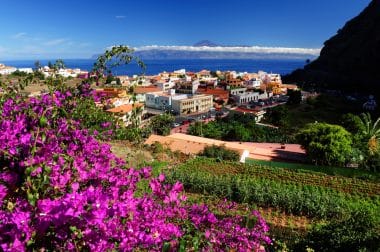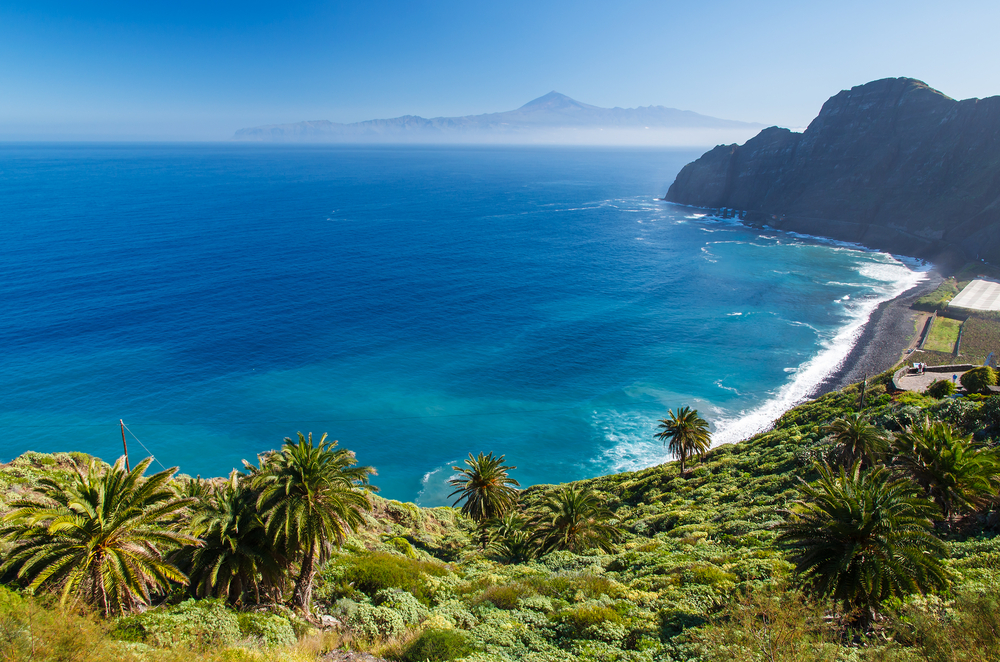Almost circular, furrowed from the core of gorges, the third smallest island of the Canary Islands lies in the Atlantic Ocean and attracts with its untouched nature. Banana plantations, palm groves, a simple rural way of life and the 1970s of the hippies, who once discovered the archipelago for themselves, still characterize the Canary Island of La Gomera today.
The authenticity, naturalness and authenticity of the island is remarkable. Sometimes La Gomera can also be quite kitschy. At the latest when a dolphin jumps out of the Atlantic in a perfect arc or the glowing sun ball dives into the sea and glides smoothly back into the water. The island of Gomera, located off the northwest African coast, is of volcanic origin and exceptionally beautiful.
Like an adventure – mysterious and captivating

La Gomera is about 10 million years old. The island keeps many secrets, arouses curiosity and also raises some questions: Is there really an organ in the sea? How dangerous is a jump into the water? Who is lurking behind the stone nests? And what exactly is the Salto del Pastor? It is worth learning a lot more about La Gomera.
Fog-shrouded highlands, rainy north, barren and dry south – La Gomera combines very different climate zones in a very small area. Everything is close together here. While sun worshippers enjoy a wonderful beach feeling, weatherproof hikers walk only a few kilometers further through a mysterious cloud forest. One thing is certain: Most of the island’s highlights reveal themselves in their diverse and unique nature.
The north of La Gomera – not only a hit for hikers
The rich north can do more than just rain. It attracts visitors with pretty mansions, old churches and traditional handicrafts. First, hikers and adventure seekers penetrate the ancient laurel forest. Enchanted, it unfolds its entire beauty. Every now and then it can get really creepy: Suddenly gusts of wind howl, the damp humus soil unfolds a musty smell, and in addition, the creaking branches of the mighty treetops sink into the ghostly field of fog.
“Isla Magica” is the name given to the notorious mixed forest in the Garajonay National Park. Locals even suspect that this is a meeting place for the witches. Like an oasis, the forest stretches up to 1500 meters above sea level in a wild, torn mountain landscape.
The Gedro Valley is the centre of the national park. Here flows a bubbling stream, entwined with ivy. Over small wooden bridges, past waterfalls, you soon reach a clearing. Here lies a picturesque enchanted chapel.
But that’s not all. Agulo is the capital of the smallest municipality of the same name. Probably the most beautiful village on the island is presented on a 200-metre-high rock dome above the sea. From here, visitors can enjoy an overwhelming view of the neighbouring island of Tenerife. The centre of Agulo is also well worth seeing.
Los Órganos is no less exciting with a natural wonder located in the cliffs of the northwest. More on that later.
The south of Gomera – picturesque harbours and a sea of palm trees in eternal spring
Together with the ferry port, the city of San Sebastián forms the center of the southeast coast of La Gomera. In the immediate vicinity of the harbour there are many historical buildings from the time of the conquest. San Sebastián is the main town of the island and was also Columbus’ last stop before the sea voyage across the Atlantic.
In the church “La Asunción” there are many reminders of it. This is also the case in the “Torre del Conde”, the count’s tower from the 16th century. Also worth seeing is the old customs house, which was also used as a prison for a time, as well as “Casa Bencom”, the “Museum of Stones”. Here visitors learn all kinds of interesting facts about the origin of the island.
The small Bergorf Arure is located on the edge of a wonderful valley. Arure is the first town above the Valle Gran Rey. Traditional stone houses adorn the old settlement, which is located at an altitude of 825 meters in a picturesque landscape. People like to linger here. The restaurant “El Jape” spoils visitors with regional delicacies.
In the valley of the “Great King” – “Valley Gran Rey” – time seems to have stood still. At the edge of the world, you can enjoy and relax. Nothing is built up here, no hustle and bustle, here and there a few people sit around on the beach. The former hippie paradise is charming, impresses in a great location and shows itself in many places as alternative. White houses nestle against the terraced mountain slopes. The port district of Vueltas forms the tourist center of this region with La Puntilla, La Playa and La Calera.
La Gomera and the most beautiful beaches
- Playa de Santiago is the island’s sun-drenched holiday centre with beautiful beaches.
- The “Valle Gran Rey”, which is well developed for tourism, offers a special variety of beaches. Just behind the harbour pier is the sandy beach Playa de Vueltas. The beach is particularly popular with families and children due to its sheltered location from the treacherous surf.
- Bathing like in a small pool – Babybeach, the mini beach near La Puntilla, offers even more protection. Rocks and stones form a kind of lagoon here and allow carefree bathing fun.
- Starting at the headland of Puntilla, the longest beach of La Gomera finally stretches out. The shallow shores and the rather calm sea are bustling with tourists and locals.
And what about the organ? Of course, our questions do not remain unanswered:
- In fact, it exists, the organ in the sea: Los Órganos is a church organ carved into the rock. This wonder of nature can only be reached by sea. Prismatic basalt columns line up on an 80-metre-high and 200-metre-wide rock face. The exposed basalt columns look like pipes of a huge organ. A jewel of nature, whose incredible beauty regularly takes visitors’ breath away.
- Jumping into the sea is actually not entirely safe in some places. Especially where the strong current and sharp rocks make the jump a dangerous undertaking. There are hardly any bathing spots in the north of the island – the suction is too unpredictable, the waves too violent. On the other hand, you can enjoy exuberant bathing fun on the southern half of Gomera. Here you can play it safe: San Sebastián, Playa de Santiago and Valle Gran Rey.
- What are the stone nests all about? It also remains a mystery for long-time Gomera travelers: The beach at Playa de Inglés seems to come and go as it pleases. Regardless of the tide and season – black gravel remains. When the rock exceeds the size of the gravel, the sun worshippers build large stone nests. In this way, they protect themselves from the wind and prying eyes.
- The Salto del Pastor was once a special technique used by goatherds to make it easier to move on steep terrain. The shepherd’s leap was created. For this you need a wooden pole (astia) up to 3.50 meters long with a metal tip on top. This allowed the shepherds to overcome steep slopes, terraces, deep ditches and the ascent without any problems. Today, the Salto del Pastor on La Gomera is a popular leisure sport.
Sights and experiences on La Gomera”: From cloud forest to beach paradise
The island of La Gomera is characterized above all by its breathtaking nature and its numerous small beaches. If you are on holiday on the island, you should definitely bring sturdy shoes. After all, there is a lot to discover here on countless long and short hiking trails.
Island capital San Sebastian de La Gomera: Under the sign of Christopher Columbus

If you are looking for sights, you will find them in the island’s capital San Sebastian de La Gomera in the east of the island. The small town of 9,000 inhabitants is mainly dedicated to the circumnavigator Christopher Columbus, who stopped here again and again on his voyages to America. In the Casa Colón Roundhouse, you can learn a lot about the explorer and his time on the island. La Casa de la Aguada also has a permanent exhibition on the discovery of America. You should also pay a visit to the Torre del Conde from the 15th century, which is still very well preserved. The impressive Church of the Resurrection Iglesia de la Asunción with its many small and large sacred works of art is always worth a visit. A leisurely stroll through the many narrow streets of the historic old town and a coffee in one of the numerous cosy cafés should also not be missed.
Los Organos Natural Monument and Garajonay Cloud Forest
If you are traveling in the north of La Gomera, you should definitely make a detour to the huge natural monument Los Organos on the north coast. The 175-metre-wide and 80-metre-high rock formation is probably the most famous sight and is also the island’s landmark. The Garajonay cloud forest in the interior of the island, which is about 2,000 years old, also attracts thousands of tourists and locals every year. As one of the oldest cloud laurel forests in the world, it is one of the most popular attractions on the entire island.
Due to the constant fog rain, a species-rich flora and fauna with 1000 different animal and almost 500 plant species has developed on the 4,000-hectare area. Among other things, green ferns up to two meters high can be found here. In addition, countless bird species, reptiles and amphibians live in the incredibly exciting national park. Instead, there are very few mammals here. In addition to animal and plant fans, hikers also get their money’s worth in the region. The national park, which is mainly characterized by the Canary Island jungle, has been a UNESCO natural heritage site since 1986 and is also a huge European bird sanctuary, is a real natural paradise for all visitors. The entire area is characterized by countless hiking trails with different levels of difficulty, making it a real paradise for hikers.
Original villages in the north, wide beaches in the south

In general, the north side of the island is just as popular with hikers and climbers as it is with young and old nature lovers. If you are looking for tranquil holiday resorts away from the big tourist crowds, this is also the place for you. In Agulo, the smallest municipality on the island, as well as in the small village of Playa de Alojera, you can get to know the original La Gomera with its many narrow streets and small houses. A popular starting point for hikes is also the village of Vallehermoso. Nearby is the Castillo del Mar, an elaborately restored former loading station for bananas, a real eye-catcher that can also be found in many holiday photos.
Not far away is the settlement of Hermigua, which is best known as the largest banana-growing area on the island. And if you’re already out and about here, you shouldn’t miss the El Chorro waterfall. Those seeking relaxation and beach holidaymakers are in the right place in the south of La Gomera in Playa de Santiago. The region around the southernmost town of the island, which also has a small harbour, is characterised above all by its sunny location and its numerous beaches. The long and impressive waterfront is home to numerous bars, restaurants and clubs. In the summer months, it is really busy here, especially in the evening and night hours – as well as in the bungalow village Jardin Tecina, which is located in the east of Playa de Santiago.
Also very popular with tourists and locals is the Valle Gran Rey in the far west of La Gomera. Due to the extremely mild climate, in addition to the many beautiful sandy beaches, the most popular tourist center of the island with numerous water sports and a lively nightlife has developed here in recent decades – including in the small towns of La Puntilla and La Playa


